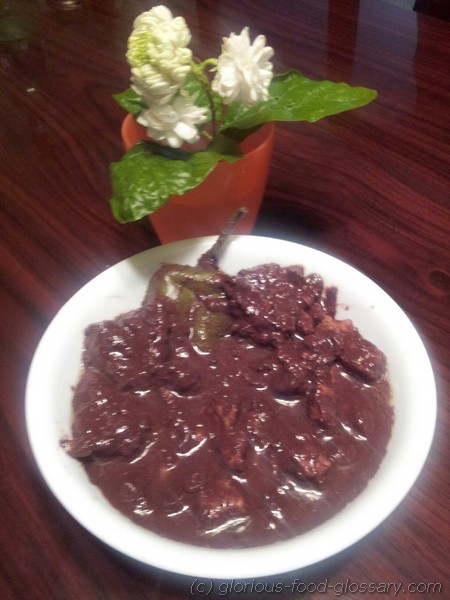Dinuguan refers to one of the traditional dishes from the Philippines. It is a pork blood stew made from cubed meat of pork that is stewed with pork blood. It is also cooked with pork innards called Laman Loob in Filipino, such as the Liver (Atay) and Intestines (Bituka). Dinuguan is cooked with vinegar, some are using fresh young tamarind leaves and lots of spicy green banana Chilies. For many lovers of this dish, the spicier it is the better.
There are various versions of Dinuguan, depending on who prepares it and from what region in the country. Some are cooking it only with pork meat , some with or without the innards, some are more dry, others are with more sauce. Some are adding pieces of Papaya and in San Pablo City, Laguna, they add noodles called Sotanghon (Vermicelli). Every region in the country has its own version of this dish.
Dinuguan is from the root word "Dugo" which means blood because the most important ingredient of this exotic dish from the Philippines is fresh Dugo ng Baboy (Pork Blood). Housewives or cooks who want to cook Dinuguan must request the pork butchers or sellers in the Wet market beforehand so they can reserved the blood from the freshly butchered pigs. On the other hand, the housewives/cooks must be at the market early in the morning to get the blood which is to be cooked at once while it is fresh.
Dinuguan is always paired with newly cooked white rice or Puto, a Filipino rice cake.
Below are various versions of Dinuguan. The first picture, is my sister's version of Dinuguan, with more and bigger cut of pork. I am actually amazed that they can buy fresh pig's blood in Houston, Texas where my sisters and my mom live

This version below has more sauce, with small pieces of meat and pork Intestines and Liver. Made by my sister-in-law's mom for our picnic. Lots and lots of green and red chilies. I will never get tired of eating Dinuguan. I always crave for it.

Below is the Dinuguan with spicy banana chilies served with newly cooked rice in a school Canteen offered for students lunch. Yummy

Below is the Dinuguan in one of the Fastfood shops in a big Mall in San Pablo City, Laguna. It only shows that, Dinuguan is always a part of traditional Filipino food, hence it is always offered in many Filipino Restaurants offering traditional Filipino food.

This version is made for the birthday party of my nephew, also in Texas. I love it so much because I have not eaten Bituka ng Baboy (pork innards) in a Dinuguan for a long time, plus, it was so oily and so spicy and so good to eat with newly cooked white rice


Related Articles to the term 'Dinuguan' | |
| 'Bicol Express' | ■■■■■■■■■■ |
| Bicol Express refers to a dish from the Philippines. Bicol Express is a traditional dishes from the Philippines, . . . Read More | |
| 'Humba' | ■■■■■■■■■■ |
| Humba a dish of stewed pork a very spicy dish made of pork or chicken from the Visayas Region of the . . . Read More | |
| 'Caldereta' | ■■■■■■■■■ |
| Caldereta in the food context refers to a rich and flavorful Filipino stew made with tender meat, typically . . . Read More | |
| 'Dinardaraan' | ■■■■■■■■ |
| Dinardaraan is a dish from the Philippines, specifically from the Ilocos Region. It is the Ilocano version . . . Read More | |
| 'Goto Batangas' | ■■■■■■■■ |
| Goto Batangas refers to a variety of Philippine Goto or rice porridge which is a specialty from Batangas. . . . Read More | |
| 'Kilawin' | ■■■■■■■■ |
| Kilawin refers to a traditional Filipino dish similar to ceviche, involving raw seafood or sometimes . . . Read More | |
| 'Pinangat' | ■■■■■■■■ |
| Pinangat is a traditional Filipino dish from the Bicol region, known for its rich coconut milk base and . . . Read More | |
| 'Bistek' | ■■■■■■■■ |
| Bistek is a Filipino version of beef steak or stir fried steak . . . . . . Read More | |
| 'Saging na Saba (Hilaw)' | ■■■■■■■■ |
| Saging na Saba (Hilaw) refers to the unripe, green version of the Saba banana, a type of cooking banana . . . Read More | |
| 'Ndoleh' | ■■■■■■■■ |
| Ndoleh refers to one of the Cameroonian specialties which is a spicy stew containing bitter leaf greens, . . . Read More | |
